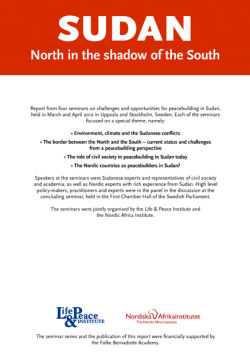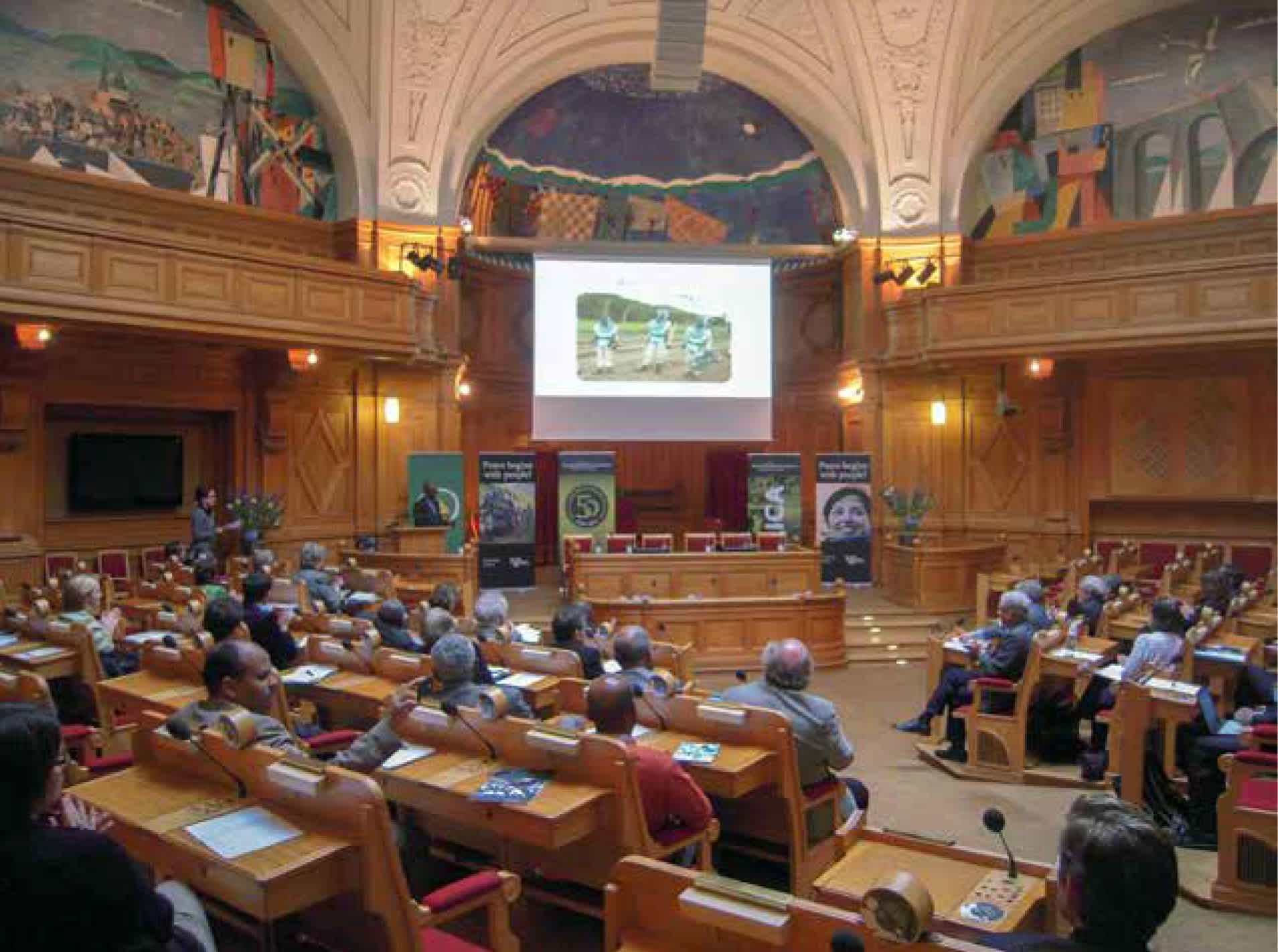Publications & reports
Sudan
North in the shadow of the South
Report from four seminars on challenges and opportunities for peacebuilding in Sudan, held in March and April 2012 in Uppsala and Stockholm, Sweden. Each of the seminars focused on a special theme, namely:
Environment, climate and the Sudanese conflicts
The border between the North and the South – current status and challenges from a peacebuilding perspective
The role of civil society in peacebuilding in Sudan today
The Nordic countries as peacebuilders in Sudan?

- Date
- Type
- Report
- Country/Region
- Sudan
Speakers at the seminars were Sudanese experts and representatives of civil society and academia, as well as Nordic experts with rich experience from Sudan. High level policy-makers, practitioners and experts were in the panel in the discussion at the concluding seminar, held in the First Chamber Hall of the Swedish Parliament. The seminars were jointly organised by the Life & Peace Institute and The Nordic Africa Institute.
Summary
When the Life & Peace Institute and the Nordic Africa Institute in the autumn of 2011 set off to plan a seminar series, it was a conscious choice to focus on the country that used to form the northern part of the old Sudan. Since its independence in July of the same year, South Sudan had received considerable attention in international media. Meanwhile, little interest was paid to Sudan. The former North had been left in the shadow of the South.
The result of the southern referendum, that paved way for the separation of the two countries, created a number of question marks. Legally the partition per se was undisputed. But otherwise the relationship between the two new countries was all but clear. How would the still pending issues be solved? What would life at the border look like? To overcome these intractabilities a holistic approach is needed, which also includes grass root initiatives that enable peace to take root locally. To be able to support these initiatives a deep understanding of the issues at stake as well as of the conflict environment is needed. With this in mind we wanted to organise a series of seminars – dynamic, with recognised experts and with fresh perspectives – to highlight the needs and prospects for peacebuilding efforts in Sudan. For the seminars Sudanese experts and representatives of civil society and academia were invited, as well as Nordic experts with rich experience from Sudan. The aim was to get experienced views on the topics chosen, but to also pose the question: how can the Nordic countries as donors respond to these challenges?
This report summarises the four seminars in the series entitled “Sudan: North in the shadow of the South”. The seminars were held in Uppsala and Stockholm in March and April 2012 and were organised by the Life & Peace Institute (LPI) and the Nordic Africa Institute (NAI). For the first and third seminar, respectively, the Uppsala Association of Foreign Affairs (UF) and ABF Stockholm joined in as organising partners. The fourth and concluding seminar was held in the First Chamber Hall of the Swedish Parliament and was organised in co-operation with the Swedish Green Party.
Global warming, whether influenced by humans or not, is one of the biggest challenges for mankind. Together with environmental degradation, climate changes form a set of conflict variables that are often overlooked, both as causes and, more locally, consequences of conflict. The first seminar in our series put the focus on environmental factors and the conflicts in Sudan. Pastoral migration, access to water and harvesting schemes are all influenced by environmental factors. However, as noted during the seminar by the speakers, Dr Gunnar Sørbø and Dr Guma Kunda Komey, the Sudanese crisis is more complex than that: it is above all a crisis of governance and a crisis of livelihood.
The second seminar came to be even more topical than expected. The theme of border issues, referring to the border between the North and the South, was on the agenda of global media due to a recent escalation between the Sudanese Armed Forces and the Sudan People’s Liberation Army. The border regime and the movement of people and goods became one of the main topics of the discussion. Both invited speakers, Dr Mohammed Ahmed Abdelghaffar and Dr Øystein Rolandsen, pointed out that the border zone is an economically vital area for both countries and its people are socially and historically inter- linked. The potential for cross-border initiatives, anchored in the local communities, should therefore be explored.
The third seminar mapped out the current field of civil society actors within the field of peacebuilding in Sudan. The organisational and structural challenges are many, but at the same time, there is a big potential for bringing the peace process down to grass roots level. Dr Buthaina Ahmed Elnaiem and Dr Yasir Awad Abdalla Eltahir requested long-term commitment from donors and a switch from a humanitarian to a development approach. Once again, the far from fully explored possibilities of building on cross-border initiatives came up as a potential way forward.
The concluding seminar gathered some high level policy-makers, practitioners and experts to discuss the potential and challenges for civil society peacebuilding in Sudan. Besides considering the potential for civil society peacebuilding, the discussion also had a donor perspective, with the aim of exploring the capabilities of the Nordic countries as peacebuilders. The panellists in many ways brought the discussion to a concrete level, pointing out ways in which practices of donors can be adapted to support civil society actors in building peace.
Each seminar in this report is presented in a separate chapter. At the end of each chapter the session is summarised in a number of highlights. A few findings stand out as exceptionally strong. One of them is the need for a holistic approach. Building peace is complex and needs to be done on all levels. The seminars confirmed that far from all tools in the box have been used and there is a need to shift from humanitarian aid strategies to those with a development perspective. A second finding, which is perhaps reflected more implicitly in the report, is that conflict labelling has consequences. Not only does it affect our perception of conflict, it also affects the conflict itself. How the international community interprets conflicts and which narratives it chooses to accept has direct consequences on the ground.
The third and perhaps strongest finding is the need to tackle Sudan and South Sudan together. The border zone is crucial to both countries, and there is no way to create stable peace in the two without taking the other into account. Sudan and South Sudan are strongly inter-linked, and denying these links will only postpone the shift from piece-bypiece, pact-by-pact agreements to all-embracing, sustainable peace.
